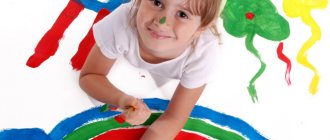General picture of the work of a self-education teacher
I have already touched on the topic of self-education several times on the pages of the blog, but I haven’t talked about the plan yet. Whatever one may say, at the beginning of each school year all educators must choose and approve this very plan. We choose the topic in accordance with the work plan of the preschool educational institution, as well as with the individual work plan for the year.
That is, if your theme is the development of fine motor skills through finger theater, then throughout the year, as planned, you must definitely implement your theme with the children. For the entire academic period, we record the stages of self-education in a special notebook, where we note everything that has been done specifically on the topic.
What does self-education work include:
- Studying thematic literature (we carefully record all authors and the titles of their works);
- Attending seminars, participating in webinars, courses, lectures, etc.;
- Conducting open classes for colleagues, giving reports, abstracts, consulting on the topic of self-education for parents and colleagues;
- Practical activities with children: classes, clubs, diagnostics, holidays, matinees, etc.
By the end of the school year, we will definitely write a report on self-education and present it to the pedagogical council. Certification will also not go smoothly without high-quality materials on the work done. If you approach the question not as an obligation, but as an opportunity to deepen your knowledge and acquire new skills, then the process of self-training will captivate you. Look, there’s enough material for the author’s manual!
Indeed, for a modern teacher, the desire for self-improvement should be natural. We have no right to be ossified, old testament or something. Our children constantly baffle us, so finding new forms of education and development for modern preschoolers is our first task. And for this you need to study, study...
Moreover, in the modern world, information loses its relevance after 5 years. This is what the statistics say. In total, the knowledge that was put into our heads at school or institute is outdated...
So that you don’t have to search for topical materials for a long time, I took on this work.
How to choose a topic for self-education?
There are only two main criteria:
- requirement to study the topic from the outside (formulated in regulatory documents, in particular, in the Federal State Educational Standard for Preschool Education);
- the work of the teacher himself (lack of experience and knowledge to resolve a particular pedagogical situation).
Thus, before choosing a topic, you need to familiarize yourself with the regulatory framework for preschool education and analyze your own experience.
According to the Federal State Educational Standard, a preschool child develops in the following areas:
- social and communicative;
- educational;
- speech;
- artistic and aesthetic;
- physical.
Online store "UchMag" - first aid
Kindergarten is a platform for preparing children for a difficult life during the school period, when the life position and personality of a citizen is formed. I would like to note that, despite my sometimes humorous and not entirely scientific language of presentation in articles, I, as a teacher, am fully aware of the responsibility that lies with me. What I will give to each pupil today is what he will go to first grade with.
Whether elementary school teachers thank me or scold me depends on my competence and interest in the effectiveness of my efforts. Therefore, I ask young colleagues not to consider work planning, including self-education, as an unnecessary waste of time for anyone, and unsubscribes for superiors. We do not work on our own, not as a private shop, but as representatives of the state education system.
It may not be perfect, but there is no other. In connection with the above, I propose that we take seriously the development of an individual work plan and try to ensure that it reflects our desire to give children solid luggage for the difficult journey from childhood to adolescence. Eh, how did I screw it up?
So, I won’t be an unfounded moralist, but I will help my young colleagues with practical advice: buy the manual “Teacher’s Work Program: Daily planning according to the program “From birth to school” (edited by Veraksa N.E. and others) from UchMag. It comes with daily planning. There is a separate work program for the middle group (4-5 years), senior group (5-6 years) and preparatory group (6-7 years).
The Federal State Educational Standard is very strict in matters of planning activities, but this particular program is fully approved and recommended by everyone in our education system. By the way, there is also a ready-made approximate plan for self-education.
I also recommend that you take part in the offline webinar “Planning methodological work according to the Rainbow program,” which will also have a very favorable effect on your horizons as a teacher.
How to make a self-education plan
1
Find out why you want to learn this skill
This is a preparatory step that should be taken very seriously. We often do thoughtless things that cost a lot: both time and money. In terms of training, everything is even more critical: you can waste several months, or even years.
This is especially true if you want to learn programming. In order to start making money in this field, they say you need to study from six months to a year and a half. So if you don't feel motivated or enthusiastic enough, then maybe it's not for you.
It's all about being intrinsically motivated. Here are some questions to ask yourself:
- Do you want to find a job that is more meaningful and important than your current one?
- Do you want to find a higher paying job?
- Do you want to change the world?
Even if the answers are a little pretentious, it is important that you understand that they are honest and frank.
The preparatory stage is completed. At the second stage, you will need a sheet of A4 paper or an electronic file. This is a must. You need to create a step-by-step instruction for yourself so that it constantly looms before your eyes and does not allow you to be distracted by anything unimportant.
2
Make a list of goals
This is not as simple as it might seem at first glance. You should come up with as many goals as possible so that you can compare them later and choose the most important one(s). So don’t limit yourself to something like “I want to learn how to create a website with WordPress” or “I want to learn how to knit a sweater.”
So, the list of goals is ready. How to choose the most important ones? First of all, you need to find out whether any of them are combined.
A combined goal is a goal that opens up more opportunities for you:
- Learning a new language can help you move to another country or get a better paying job.
- Learning Java will increase your income several times.
If you learn to knit a sweater, then most likely it will be an end in itself.
Therefore, ideally, you should choose goals that will significantly move you forward. This also has a positive effect on motivation.
Select one to three goals. There shouldn't be too many of them. At the same time, they can be quite ambitious, but not prohibitive.
3
Make a list of resources
You can either find everything you need on the Internet. Here are the resources you should consider:
- MOOC courses;
- books;
- magazines;
- blogs;
- educational videos;
- attending conferences and lectures;
- internship;
- volunteer work;
- trips;
- finding a mentor.
At the same time, you must understand that there is not enough time for everything. It is important to choose 3-5 main resources and focus on them. The rest is only worth pursuing if you purposefully set aside time to try something new.
4
Set key learning points
These are the points by which you can track your progress. Learning is a long process and sometimes boring, but the main difficulty is that you will not immediately get results.
In addition, an ambitious goal can easily suppress your psyche, especially at times when motivation tends to zero. Therefore, establish the key points:
- a certain number of written pages;
- website creation;
- Intermediate level in English;
- creating a phone application.
5
Set a schedule and daily routine
Learning is not something you can cram into your life and hope it will work. This is the basis, the Sun, around which all planets must revolve. Don't forget that you are studying to make your life significantly better, which means that this becomes your top priority.
Create a time frame for each goal . What are you going to do today, tomorrow, next week, in six months to achieve your goal? Make sure you master time management skills and learn how to properly manage your time.
Create a daily routine . You must change your life, because it will no longer be the same - it is naive to hope for this. A lot will change because you will be dedicating a large amount of time to learning.
So, let's repeat: you must change your daily routine, book time to learn your skill. And also set a deadline in order to keep yourself on your toes.
6
Track your progress
Tracking progress is the very process that positively affects the level of motivation. As has already been said, during the learning process you will not immediately begin to receive practical results, which means you can give up at any time. But not if you track your progress.
By tracking we primarily mean keeping a diary. You write down everything you studied and how you studied it, as well as how much time it took. Document every little detail. After a few weeks, it will be possible to draw certain conclusions based on this information. You will learn to identify trends, understand your strengths and weaknesses, bad and good habits. And finally, you will begin to draw the right conclusions, adjusting both your behavior and your self-education plan.
The English-language Internet offers a wide variety of applications that you can use to track your learning progress in order to adjust your plan if there are inaccuracies or gaps in it.
- Degreed. Learners use Degreed to quantify, track, and organize learning from any source, both formal and informal.
- Diigo. Simplify the operation of your information system and improve performance. Also adds digital marks and notes to PDFs, saves links, images and pages, and encourages collaboration and sharing with other students.
- TopTracker. This app can be used to track the time you spend in Photoshop or other digital tools (and therefore suitable for web designers and programmers).
The writer Isaac Asimov is said to have once said, “Self-education is the only education you have.” It’s hard to argue with this, because you are the one who knows best what you want to study. The main thing is to create an effective plan and strictly follow it.
We wish you good luck!
Did you like the article? Join our communities on social networks or our Telegram channel and don’t miss the release of new useful materials: TelegramVKontakteFacebook
We also recommend reading:
- Storytelling
- Best of the year. Part three
- Contingency planning
- A Guide to Creating a Personal Development Plan
- Personal goal setting
- Secrets of self-education
- Should you have a plan B?
- How to convert your abilities into money
- Rules and secrets of self-education
- Business motivation model
- Four steps to create a personal development plan
Keywords:1LLL
Making a plan for self-education: step-by-step instructions
How to properly draw up a work plan for self-improvement:
- We design the title page according to well-known canons; you can simply download it on the Internet. But be sure to indicate the name of the preschool institution, write that this is a plan for self-education of such and such a teacher (full name, experience, category), write down the topic, period of work (from September 2021 to May 2017) and the age group of children;
- Next pages: topic, goal, tasks. We know the topic, the goal comes directly from the topic. The tasks are as follows: to increase the level of knowledge on the issue by studying relevant literature, attending training seminars, and independent research work.
The tasks also include developing a long-term work plan in accordance with the topic of self-education, preparing diagnostics at the beginning and end of the year, creating a curriculum, organizing a circle for children and other practical activities that you plan to carry out. This could also be the design of a corner, holding consultations, a seminar, a lecture.
- Expected results for self-education. We write them based on the tasks. We just put it in other words and add about the children’s achievements.
- Specific stages of self-education work. A table is appropriate here: we break it down by month of the school year, distribute work with children, parents, colleagues, and independent work. We include everything that we will conduct and do on the topic: literature studies, classes, seminars, consultations, stand design, exhibitions, moving folders, etc.
- Output topic: final results. Here you can indicate an open lesson, a master class for colleagues, a consultation for parents, the design of an exhibition or moving folder, a report at a teachers' meeting.
As you can see, nothing complicated. It’s even easier to download a special plan form and draw up your plan based on the sample.
Before I tire you, I'll finish. In parting, I’ll ask you to do me a favor: share the link with your friends and if you haven’t subscribed yet, you’re welcome to join our company!
Sincerely, Tatyana Sukhikh! Till tomorrow!
By the way, I recommend reading:
Four types of plans
We will talk about four types of plans, each of which you can use independently or combine. Create something of your own that suits you.
Time based plan
This plan is universal: it is suitable for those who want to study one or several subjects at once.
Everything is simple here: you “book” a certain amount of time in the morning, afternoon and/or evening, after which you create your schedule, hang it on the wall and stick to it.
Place based plan
It's a cunning plan because it puts you in a position where you can't help but learn.
Places can be very different:
- a park;
- library;
- favorite cafe;
- public transport.
The essence of such plans is that you purposefully go there to learn. Surprisingly, sometimes it’s easier to motivate yourself to do it in the library rather than in the next room.
And, of course, it can be combined with the foreground.
Free plan
The free plan is fundamentally different from the others in that no goals are set during the learning process. Instead, you should keep a journal in which you record what you've learned, what progress you've made, and where you're going.
With this approach, you are often surprised because you simply give yourself, say, two hours of time without knowing what you will study. Some freshness remains and motivation increases.
The disadvantage of this plan lies in its own advantage: you can waste a huge amount of time on unnecessary things.
Goal Based Plan
To create this plan, you need to find three main goals that you want to achieve. Based on them, the entire training program is built.
This plan can be combined with others to find the perfect balance and satisfaction.
Now let's find out how to create a self-education plan.


